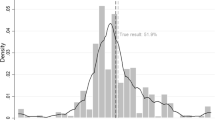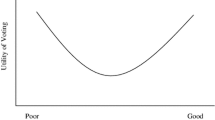Abstract
Little attention has been paid to the influence of expectations for victory on the formation of general election preferences in U.S. presidential races. There is good reason to believe, however, that under certain conditions citizens' forecasts of who will win the fall election may influence their preference and their vote. We model preferences during the course of the fall 1992 campaign as a function of two kinds of expectations. First we attempt to identify a component of expectations that is independent of political projection. We discover that expectations based only on information about the race play a prominent role in preference formation early in the fall but decline later as the cost of information drops. Similar results obtain when we include projection in the model of expectations. We conclude that general elections may have some of the same dynamic properties that are observable in primaries. Since early momentum in the fall campaign may influence subsequent preference formation, we contend that leads in early polls are valuable.
Similar content being viewed by others
REFERENCES
Abramson, Paul R., Aldrich, John H., Paolino, Phil, and Rohde, David W. (1992). Sophisticated voting in the 1988 presidential primaries. American Political Science Review 86: 55-69.
Aldrich, John H. (1980). A dynamic model of presidential nomination campaigns. American Political Science Review 74: 651-669.
Axelrod, Robert (1972). Where the votes come from: An analysis of electoral coalitions, 1952–1968. American Political Science Review 66: 11-20.
Bartels, Larry M. (1985). Expectations and preferences in presidential nominating campaigns. American Political Science Review 79: 804-815.
Bartels, Larry M. (1987). Candidate choice and the dynamics of the presidential nominating process. American Journal of Political Science 30: 709-728.
Bartels, Larry M. (1988). Presidential Primaries and the Dynamics of Public Choice. Princeton, NJ: Princeton University Press.
Bartels, Larry M. (1993). Messages received: The political impact of media exposure. American Political Science Review 87: 267-284.
Bowler, Shaun, and Lanoue, David J. (1992). Strategic and protest voting for third parties: The case of the Canadian NDP. Western Political Quarterly 45: 485-499.
Brady, Henry (1984). Knowledge, strategy and momentum in presidential primaries. Paper presented at the Weingart Conference, California Institute of Technology.
Brady, Henry (1985). Media and momentum. Paper presented at the Annual Meeting of the American Political Science Association, New Orleans.
Berelson, Bernard R., Lazarsfeld, Paul F., and McPhee, William N. (1954). Voting: A Study of Opinion Formation in a Presidential Campaign. Chicago: University of Chicago Press.
Campbell, Angus, Converse, Philip E., Miller, Warren E., and Stokes, Donald E. (1960). The American Voter. Chicago: University of Chicago Press.
Carmines, Edward G., and Stimson, James A. (1989). Issue Evolution: Race and the Transformation of American Politics. Princeton, NJ: Princeton University Press.
Ceci, Stephen J., and Kain, Edward L. (1982). Jumping on the bandwagon with the underdog: The impact of attitude polls on polling behavior. Public Opinion Quarterly 46: 228-242.
Fiorina, Morris P. (1990). Information and rationality in elections. In John A Ferejohn and James Kuklinlei (eds.), Information and Democratic Processes. Urbana: University of Illionois Press.
Frankovic, Kathleen (1993). Public opinion in the 1992 campaign. In Gerald M. Pomper (ed.), The Election of 1992, pp. 75-109. Chatham, NJ: Chatham House.
Gelman, Andrew, and King, Gary. (1993). Why are American presidential election campaign polls so variable when votes are so predictable? British Journal of Political Science 23: 409-451.
Gimpel, James G., and Doherty, Kathryn (1994). Partisanship, information and the public reaction to issues of candidate character. Paper presented at the 1994 Conference of the American Political Science Association, New York City, September 1–5.
Hosmer, David, and Lemeshow, Stanley (1989). Applied Logistic Regression. New York: John Wiley & Sons.
Jacoby, William G. (1988). The sources of Liberal—Conservative thinking: Education and conceptualization. Political Behavior 10(4): 316-332.
Kinder, Donald R., and Kiewiet, D. Roderick (1979). Economic grievances and political behavior: The role of personal discontents and collective judgments in congressional voting. American Journal of Political Science 23: 495-527.
Kramer, Gerald H. (1971). Short-term fluctuations in U.S. voting behavior, 1896–1964. American Political Science Review 65: 131-143.
Krosnick, John A. (1990). Americans' perceptions of presidential candidates: A test of the projection hypothesis. Journal of Social Issues 46: 159-182.
Krosnick, John A., and Milburn, Michael (1990). Psychological determinants of political opinionation. Social Cognition 8: 49-72.
Krosnick, John A., and Telhami, Shibley (1994). Public attitudes toward Israel: A study of the attentive and issue publics. Forthcoming.
Kuklinski, James, and West, Darrell (1981). Economic expectations and voting behavior in U.S. House and Senate elections. American Political Science Review 75: 436-447.
Lewis-Beck, Michael S. (1985). Pocketbook voting in U.S. National Election Studies. American Journal of Political Science 29: 348-357.
Lewis-Beck, Michael S. (1988). Economics and Elections: The Major Western Democracies. Ann Arbor: University of Michigan.
Lewis-Beck, Michael S., and Skalaban, Andrew (1989). Citizen forecasting: Can voters see into the future? British Journal of Political Science 19: 146-153.
MacKuen, Michael B., Erikson, Robert S., and Stimson, James A. (1992). Peasants or bankers? The American electorate and the U.S. economy. American Political Science Review 86: 597-611.
Maddala, G. S. (1983). Limited Dependent and Qualitative Variables in Econometrics. Cambridge: Cambridge University Press.
Markus, Gregory B., and Converse, Philip (1979). A dynamic simultaneous equation model of electoral choice. American Political Science Review 73: 1055-1070.
Marsh, Catherine (1984). Back on the bandwagon: The effect of opinion polls on public opinion. British Journal of Political Science 15: 51-74.
Monroe, Kristen R. (1978). Economic influences on presidential popularity. Public Opinion Quarterly 42: 360-369.
Nadeau, Richard, Niemi, Richard G., and Amato, Timothy (1994). Expectations and preferences in British general elections. American Political Science Review 88: 371-383.
Nelson, Michael, ed. (1993). The Elections of 1992. Washington, DC: CQ Press.
Niemi, Richard G., Whitten, Guy, and Franklin, Mark N. (1992). Constituency characteristics, individual characteristics and tactical voting in the 1987 British general election. British Journal of Political Science 22: 229-254.
Page, Benjamin I and Jones, Calvin C. (1979). Reciprocal effects of policy preference, party loyalty, and the vote. American Political Science Review 73: 1071-1089.
Peffley, Mark (1985). The voter as juror: Attributing responsibility for economic conditions. In Heinz Eulau and Michael S. Lewis-Beck (eds.), Economic Conditions and Electoral Outcomes. New York: Agathon Press.
Pomper, Gerald M., ed. (1993). The Election of 1992. Chatham, NJ: Chatham House Publishers.
Retherford, Robert D., and Choe, Minja Kim (1993). Statistical Models for Causal Analysis. New York: Wiley.
Robinson, Michael J. (1977). Television and American politics: 1956–1976. The Public Interest 48(2): 3-39.
Schuman, Howard, and Preser, Stanley (1981). Questions and Answers in Attitude Surveys. New York: John Wiley & Sons.
Shapiro, Robert Y., and Conforto, Bruce M. (1980). Presidential performance, the economy and the public's evaluation of economic conditions. Journal of Politics 42: 49-67.
Skalaban, Andrew (1988). Do the polls affect elections? Political Behavior 10: 136-150.
Southwell, Priscilla L. (1989). Strategic voting in the 1984 Democratic presidential primaries. Social Science Journal 26: 445-453.
Stokes, Donald, and DiIulio, John J., Jr. (1993). The setting: Valence politics in modern elections. In Michael Nelson (ed.), The Elections of 1992, pp. 1-20. Washington, DC: CQ Press.
Author information
Authors and Affiliations
Rights and permissions
About this article
Cite this article
Gimpel, J.G., Harvey, D.H. Forecasts and Preferences in the 1992 General Election. Political Behavior 19, 157–175 (1997). https://doi.org/10.1023/A:1024810225641
Issue Date:
DOI: https://doi.org/10.1023/A:1024810225641




